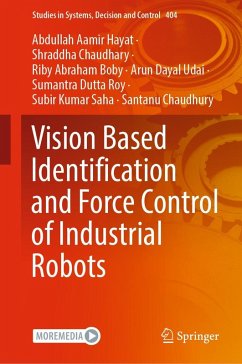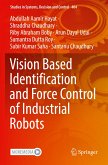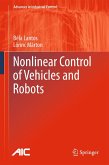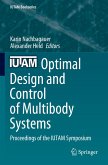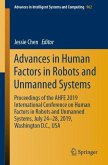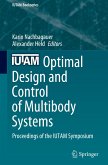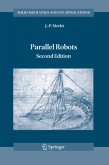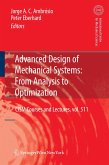Abdullah Aamir Hayat, Shraddha Chaudhary, Riby Abraham Boby
Vision Based Identification and Force Control of Industrial Robots
Abdullah Aamir Hayat, Shraddha Chaudhary, Riby Abraham Boby
Vision Based Identification and Force Control of Industrial Robots
- Gebundenes Buch
- Merkliste
- Auf die Merkliste
- Bewerten Bewerten
- Teilen
- Produkt teilen
- Produkterinnerung
- Produkterinnerung
This book focuses on end-to-end robotic applications using vision and control algorithms, exposing its readers to design innovative solutions towards sensors-guided robotic bin-picking and assembly in an unstructured environment. The use of sensor fusion is demonstrated through a bin-picking task of texture-less cylindrical objects. The system identification techniques are also discussed for obtaining precise kinematic and dynamic parameters of an industrial robot which facilitates the control schemes to perform pick-and-place tasks autonomously without any interference from the user. The…mehr
Andere Kunden interessierten sich auch für
![Vision Based Identification and Force Control of Industrial Robots Vision Based Identification and Force Control of Industrial Robots]() Abdullah Aamir HayatVision Based Identification and Force Control of Industrial Robots110,99 €
Abdullah Aamir HayatVision Based Identification and Force Control of Industrial Robots110,99 €![Nonlinear Control of Vehicles and Robots Nonlinear Control of Vehicles and Robots]() Béla LantosNonlinear Control of Vehicles and Robots74,99 €
Béla LantosNonlinear Control of Vehicles and Robots74,99 €![Optimal Design and Control of Multibody Systems Optimal Design and Control of Multibody Systems]() Optimal Design and Control of Multibody Systems125,99 €
Optimal Design and Control of Multibody Systems125,99 €![Advances in Human Factors in Robots and Unmanned Systems Advances in Human Factors in Robots and Unmanned Systems]() Advances in Human Factors in Robots and Unmanned Systems74,99 €
Advances in Human Factors in Robots and Unmanned Systems74,99 €![Optimal Design and Control of Multibody Systems Optimal Design and Control of Multibody Systems]() Optimal Design and Control of Multibody Systems125,99 €
Optimal Design and Control of Multibody Systems125,99 €![Parallel Robots Parallel Robots]() J.-P. MerletParallel Robots142,99 €
J.-P. MerletParallel Robots142,99 €![Advanced Design of Mechanical Systems: From Analysis to Optimization Advanced Design of Mechanical Systems: From Analysis to Optimization]() Advanced Design of Mechanical Systems: From Analysis to Optimization110,99 €
Advanced Design of Mechanical Systems: From Analysis to Optimization110,99 €-
-
-
This book focuses on end-to-end robotic applications using vision and control algorithms, exposing its readers to design innovative solutions towards sensors-guided robotic bin-picking and assembly in an unstructured environment. The use of sensor fusion is demonstrated through a bin-picking task of texture-less cylindrical objects. The system identification techniques are also discussed for obtaining precise kinematic and dynamic parameters of an industrial robot which facilitates the control schemes to perform pick-and-place tasks autonomously without any interference from the user. The uniqueness of this book lies in a judicious balance between theory and technology within the context of industrial application. Therefore, it will be valuable to researchers working in the area of vision- and force control- based robotics, as well as beginners in this inter-disciplinary area, as it deals with the basics and technologically advanced research strategies.
Produktdetails
- Produktdetails
- Studies in Systems, Decision and Control 404
- Verlag: Springer / Springer Nature Singapore / Springer, Berlin
- Artikelnr. des Verlages: 978-981-16-6989-7
- 1st ed. 2022
- Seitenzahl: 220
- Erscheinungstermin: 22. März 2022
- Englisch
- Abmessung: 241mm x 160mm x 18mm
- Gewicht: 500g
- ISBN-13: 9789811669897
- ISBN-10: 9811669899
- Artikelnr.: 62540624
- Herstellerkennzeichnung Die Herstellerinformationen sind derzeit nicht verfügbar.
- Studies in Systems, Decision and Control 404
- Verlag: Springer / Springer Nature Singapore / Springer, Berlin
- Artikelnr. des Verlages: 978-981-16-6989-7
- 1st ed. 2022
- Seitenzahl: 220
- Erscheinungstermin: 22. März 2022
- Englisch
- Abmessung: 241mm x 160mm x 18mm
- Gewicht: 500g
- ISBN-13: 9789811669897
- ISBN-10: 9811669899
- Artikelnr.: 62540624
- Herstellerkennzeichnung Die Herstellerinformationen sind derzeit nicht verfügbar.
Dr. Abdullah Aamir Hayat received his Bachelor of Technology in Mechanical Engineering and Master's from the Zakir Hussain College of Engineering and Technology (ZHCET), AMU, India. He completed his Ph.D. in 2018 from the Department of Mechanical Engineering at Indian Institute of Technology (IIT) Delhi. He worked as a Junior Research Fellow (JRF) at the Programme for Autonomous Robotics (PAR) Laboratory under the project granted by BARC/BRNS Mumbai during his Ph.D. He assisted and provided solutions for the research organizations and companies like CMERI Durgapur, Brabo Robotics and Automation, TATA Motors, Pune India, and Oceania Robotics Singapore. He has published several peer reviewed articles, 2 design patents, and reviewed articles for major conferences and journals. His research interests include kinematic identification, calibration, multibody dynamics, design thinking and innovation, and reconfigurable robots. Dr. Shraddha Chaudhary received her Bachelor of Technology in Electronics and Communication Engineering from Bhartiya Vidyapeeth College of Engineering (BVCOE), GGSIPU, India, in 2007 and Master of Technology in 2012 from Delhi Technological University (formerly DCE). She completed her Ph.D. in 2018 from the Department of Electrical Engineering (Computer Technology) at the Indian Institute of Technology (IIT) Delhi. She worked as a Junior Research Fellow (JRF) at the Programme for Autonomous Robotics (PAR) Laboratory under the project "Vision guided control of a Robotic manipulator" 2010-2016) granted by BARC/BRNS Mumbai during her Ph.D. Her research interests include computer vision, robotics, and machine learning. Currently, she is working as a principal project scientist for NOKIA's outsourced project related to mobile robotics at the IIT Delhi. Dr. Riby Abraham Boby did his Bachelor's from National Institute of Technology (NIT) Karnataka,Master's from Indian Institute of Technology (IIT) Madras and Ph.D. from Indian Institute of Technology (IIT) Delhi. He has been an exchange student at Technical University Munich, Germany and has been involved in academic collaboration with Graduate School of IPS, Waseda University, Japan. His research interests lie in the areas of machine vision, robotics and biometrics. He has been actively involved in research since 2007, and published more than 20 articles in international journals and conferences. He has also been a reviewer for major international conferences and journals in these areas. He is working as Senior Researcher at Innopolis University, Russia from 2019, and is involved in conducting research on calibration of robots using vision systems. Dr. Arun Dayal Udai is a Faculty in the Department of Mechanical Engineering, Indian Institute of Technology (ISM) Dhanbad, India. He has over 13 years of teaching experience in Robotics, Automation, and CAD domains. He completed his Ph.D. in 2016 from the Indian Institute of Technology (IIT) Delhi, India with a specialization in Force Control of Industrial Robots. He pursued his Master's in Mechanical Engineering Design from BIT Mesra, India in 2006 where he worked on Biped Robots. His research interests include robotics, mechatronics, and CAD. He has published in various peer-reviewed journals and conferences. Currently, he is making 6-RSS Parallel Robots - Aruni and Santulan which are useful for academics and research purposes and provides consultancy to various industries in robotics and automation. Prof. Sumantra Dutta Roy is a B.E. (Computer Engineering) from D.I.T., Delhi (1993), and completed his M.Tech. and Ph.D. degrees at the Department of Computer Science and Engineering, Indian Institute of Technology (IIT) Delhi, in 1995 and 2001, respectively. He started his career teaching and research in the Department of Electrical Engineering at IIT Bombay. He is currently Professor in the Department of Electrical Engineering at IIT Delhi. He is a recipient of 2004 INAE Young Engineer Award (Indian National Academy of Engineering), and the 2004 - 05 BOYSCAST Fellowship of the Department of Science and Technology, Government of India. His research interests are in computer vision and image analysis, video and image coding, biometrics, music information retrieval, and medical informatics. Prof. Subir Kumar Saha a 1983 mechanical engineering graduate from the RE College (now NIT), India, completed his M.Tech. from Indian Institute of Technology (IIT) Kharagpur, India, and Ph.D. from McGill University, Canada. Upon completion of his Ph.D., he joined Toshiba Corporation's R&D Centre in Japan. After 4-years of work experience in Japan, he has been with IIT Delhi since 1996. He is actively engaged in teaching, research, and technology, and completed projects worth morethan USD 1.0 million. He established the Mechatonics Laboratory at IIT Delhi in 2001. As recognition of his international contributions, Prof. Saha was awarded the Humboldt Fellowship in 1999 by the AvH Foundation, Germany, and the Naren Gupta Chair Professorship at IIT Delhi in 2010. He has also been a visiting faculty to universities in Canada, Australia, and Italy. He has more than 175 research publications in reputed journals/conference proceedings and delivered more than 150 invited/keynote lectures in India and abroad. Prof. Santanu Chaudhury is the Director of Indian Institute of Technology (IIT) Jodhpur. Prof. Chaudhury holds B.Tech. (Electronics and Electrical Communication Engineering) and Ph.D. (Computer Science & Engineering) degrees from IIT Kharagpur. He joined as Faculty Member in the Department of Electrical Engineering, IIT Delhi in 1992. He has served as Director of CSIR-CEERI, Pilani, during 2016-18. Prof. Chaudhury is a recipient of the Distinguished Alumnus award from IIT Kharagpur. He is a Fellow of Indian National Academy of Engineers (INAE) and National Academy of Sciences (NAS). He is a Fellow of International Association Pattern Recognition (IAPR). He was awarded the INSA (Indian National Science Academy) Medal for Young Scientists in 1993. He received ACCS-CDAC award for his research contributions in 2012. A keen researcher and a thorough academic, Prof. Chaudhury has about 300 publications in peer reviewed journals and conference proceedings, 15 patents and 4 authored/edited books to his credit.
Introduction.- Vision System and Calibration.- Uncertainty and Sensitivity Analysis.- Identification.- Force Control and Assembly.- Integrated Assembly and Performance Evaluation.- Conclusion.- Vision and Uncertainty Analysis.- Robot Jacobian.- Code Snippets and Experimental Videos.
Introduction.- Vision System and Calibration.- Uncertainty and Sensitivity Analysis.- Identification.- Force Control and Assembly.- Integrated Assembly and Performance Evaluation.- Conclusion.- Vision and Uncertainty Analysis.- Robot Jacobian.- Code Snippets and Experimental Videos.

